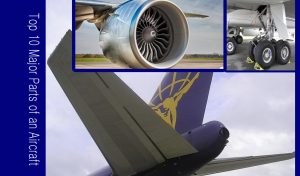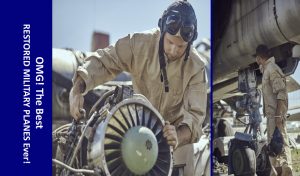Hold onto your boarding passes, folks, because we’re about to embark on a mind-blowing journey into the heart of an airplane! Today, we’re cracking the code behind its majestic flight, focusing on the Top 10 Major Parts of an Aircraft that orchestrate this aerial symphony. Get ready for a 200% content boost, packed with captivating visuals and insights that’ll leave you feeling like an honorary flight engineer!
Top 10 Major Parts of an Aircraft:
1.Fuselage: Plane’s heart, houses everything!
2.Wings: Dancing with wind, generate lift for flight.
3.Tail Unit: Balance keeper, prevents wobbles and glides smoothly.
4.Engines: Powerhouses, roar or hum to propel forward.
5.Landing Gear: Ballerina-like touchdown, smooth transition from sky to ground.
6.Cockpit: Command center, pilots orchestrate the flight.
7.Passenger Cabin: Your sky home, comfort and entertainment all around.
8.Cargo Hold: Unsung hero, delivers goods connecting the world.
9.Avionics & Navigation: Plane’s GPS and compass, charts the precise course.
10.Auxiliary Systems: Behind-the-scenes crew, keeps everything functioning.
Remember, these parts work together like a symphony, making flight a reality! Soar high!
1. The Fuselage: The Beating Heart of the Beast
The fuselage of an aircraft is its central structure, often referred to as the aircraft’s backbone. This cylindrical body serves as the vessel for passengers, cargo, and critical components, making it the heart of the flying machine. Housing everything from the cockpit and avionics to the passenger cabin and cargo hold, the fuselage provides the necessary structural integrity and cohesion for the entire aircraft

Designed with meticulous attention to aerodynamics and structural strength, the fuselage plays a pivotal role in the overall performance of the aircraft. Its sleek and streamlined form is crafted to minimize air resistance, allowing the aircraft to cut through the atmosphere with efficiency. The fuselage is not merely a hollow tube; it’s a carefully engineered structure that withstands the forces experienced during flight, including turbulence and varying air pressures.
Beyond its structural significance, the fuselage is a symbol of connectivity, facilitating the movement of people and goods across the globe. It is a testament to the engineering prowess that enables the marvel of flight. In essence, the fuselage is more than the body of an aircraft; it’s the embodiment of precision engineering, safety, and the gateway to the boundless skies.
2. The Wings: Dancing with the Wind
The wings of an aircraft are its defining feature, embodying the very essence of flight. Functioning as dynamic airfoils, these expansive structures play a crucial role in generating lift, allowing the aircraft to defy gravity and take to the skies. Crafted with precision, wing design varies across different aircraft types, each tailored to specific aerodynamic needs.

Dancing with the wind, the wings showcase a harmonious relationship between form and function. Their curved surfaces, often complemented by winglets, contribute to aerodynamic efficiency, minimizing drag and maximizing lift. This intricate dance ensures stability and control during flight, allowing the aircraft to navigate through the atmosphere with grace.
3. The Tail Unit: Maintaining the Delicate Balance
The tail unit of an aircraft is the unsung hero, diligently maintaining the delicate balance crucial for stable flight. Often overshadowed by the wings and engines, this section comprises the horizontal stabilizer, vertical stabilizer, and rudder, collectively ensuring equilibrium in the skies.

In the intricate ballet of flight, the tail unit prevents wobbles and oscillations, acting as a stabilizing force. The horizontal stabilizer counters the nose’s tendency to pitch up or down, contributing to a level flight path. Meanwhile, the vertical stabilizer, with its fin-like structure, prevents undesirable yawing, maintaining a straight course.
Think of the tail unit as a guardian angel, gracefully guiding the aircraft through the air. It’s the counterforce to the forces exerted by the wings and engines, preventing unwanted tilts and rolls. This dynamic equilibrium is particularly crucial during takeoff, landing, and maneuvers, ensuring a smooth and controlled flight experience for passengers and crew.
As the aircraft navigates the skies, the tail unit remains vigilant, responding to aerodynamic forces and pilot inputs. It exemplifies the engineering finesse required to maintain the delicate balance that is the essence of safe and controlled flight.
4. The Engines: Powering the Dream into Reality
The engines of an aircraft are the formidable powerhouses that transform the dream of flight into a tangible reality. Roaring or humming with immense power, these mechanical marvels propel the aircraft forward, defying gravity and making the skies accessible.
At the heart of aviation’s triumph, aircraft engines are meticulously designed to harness and convert energy, typically derived from combustion. Whether it’s the thunderous roar of a jet engine or the rhythmic hum of a propeller, the power generated is awe-inspiring.

Beyond their auditory impact, engines are the driving force behind the aircraft’s movement. They produce the thrust necessary for takeoff, maintain altitude during flight, and control the descent for a safe landing. The engineering intricacies involved in designing engines are a testament to human innovation, with a focus on efficiency, reliability, and performance.
Aircraft engines are the embodiment of the aviation dream, allowing humanity to traverse vast distances in the sky. They signify the fusion of engineering brilliance and a deep-seated human desire to conquer the boundless expanse above. In the symphony of flight, the engines play a leading role, transforming aspirations into the reality of soaring through the clouds.
5. The Landing Gear: A Smooth Touchdown Awaits
The landing gear of an aircraft, often underestimated, is the silent choreographer of a graceful performance during touchdown. Much like a ballerina executing a flawless routine, the landing gear ensures a smooth and controlled transition from the boundless sky to solid ground.
Comprising wheels, struts, and intricate systems, the landing gear absorbs the impact of landing, mitigating the forces generated during descent. It is engineered to handle diverse terrains, from smooth runways to rugged landscapes, providing a universal solution for safe landings.

The balletic touchdown orchestrated by the landing gear is not merely a mechanical feat; it’s a crucial aspect of passenger comfort and overall safety. The retractable nature of modern landing gear adds an element of aerodynamic efficiency during flight, minimizing drag and optimizing fuel consumption.
Pilots rely on the landing gear to execute precise landings, ensuring a gentle touch on the runway. This complex yet essential system embodies a meticulous blend of engineering and aeronautical expertise. As the aircraft descends, passengers may not be aware of the ballet happening beneath them, but the landing gear ensures that the journey concludes with finesse, promising a smooth arrival at the destination. In the aviation symphony, the landing gear takes its bow, providing the passengers with a serene and secure conclusion to their airborne adventure.
6. The Cockpit: The Command Center of the Skies
This is where the magic happens! The cockpit is the nerve center of the airplane, the command center where the pilots orchestrate the aerial symphony. Packed with a myriad of instruments, controls, and displays, it’s the hub of crucial decisions, strategic navigation, and expert monitoring. Think of it as the bridge of a spaceship, but with stunning panoramic views and the thrill of soaring through the clouds.

7. The Passenger Cabin: Your Home in the Sky
This is where we, the passengers, experience the wonder of flight. From comfy seats and legroom to in-flight entertainment systems and mesmerizing window views, the passenger cabin is designed to make our journey enjoyable and memorable. It’s our temporary home in the sky, a place to relax, work, or simply marvel at the breathtaking beauty of our planet from above.

8. The Cargo Hold: The Unsung Hero Behind Every Delivery
While we bask in the comfort of the cabin, the cargo hold works tirelessly below. It’s the unsung hero of every flight, carrying everything from essential goods like medicine and electronics to precious gifts and everyday necessities. From bustling hubs to remote destinations, the cargo hold connects businesses and communities across the globe, ensuring the smooth flow of products that keep our world running.

9. Avionics & Navigation Systems: Precisely Charting the Course
Avionics and navigation systems are the technological brains of an aircraft, akin to its GPS and compass. This dynamic duo encompasses a sophisticated array of electronics, ensuring precise navigation, communication, and monitoring. Avionics orchestrate the flight, managing everything from autopilot functions to weather radar. Navigation systems chart the aircraft’s course through the skies with unparalleled accuracy, facilitating safe and efficient journeys. As the nerve center of modern aviation, avionics and navigation systems exemplify the marriage of cutting-edge technology and aeronautical prowess, guiding aircraft through the vast expanse of the sky with precision and reliability.

10.Auxiliary Systems: Behind-the-scenes crew, keeps everything functioning.
Auxiliary systems in an aircraft operate as the unsung heroes, working behind the scenes to ensure the seamless functionality of various components. These systems encompass a range of crucial elements such as hydraulics, electrical systems, and other supporting mechanisms. Acting as the invisible crew, they contribute to the overall reliability, safety, and efficiency of the aircraft. From powering essential functions to maintaining optimal conditions within the aircraft, auxiliary systems play a vital role in sustaining the intricate network that keeps the aircraft operational throughout its journey, underscoring their importance in the aviation landscape.
Frequently Asked Questions (FAQs)
Q1: Why are aircraft wings so differently shaped?
A1: Wing design varies based on the aircraft’s purpose. Some are optimized for speed, while others prioritize fuel efficiency and lift.
Q2: What makes the cockpit the nerve center of the aircraft?
A2: The cockpit houses crucial controls, instruments, and communication systems, allowing pilots to navigate and control the aircraft.
Q3: How do engines generate thrust for flight?
A3: Aircraft engines generate thrust through the combustion of fuel, propelling the aircraft forward.
Q4: Why is the tail section important for stability?
A4: The tail, with components like the vertical stabilizer, helps maintain balance and stability during flight.
Q5: What role does avionics play in modern aircraft?
A5: Avionics encompasses navigation, communication, and monitoring systems, essential for safe and efficient flight.
Q6: How does the landing gear contribute to a safe landing?
A6: The landing gear absorbs the impact of landing, providing a smooth and controlled touchdown.
Q7: Why is the fuselage considered the central nervous system of an aircraft?
A7: The fuselage houses vital components, passengers, and cargo, serving as the aircraft’s core structure.
Q8: What purpose does the radome serve on an aircraft?
A8: The radome protects radar equipment from environmental factors, ensuring reliable navigation and communication.
Q9: How do airbrakes contribute to the safety of flight?
A9: Airbrakes help control the aircraft’s speed and descent, enhancing safety during various phases of flight.
Q10: Why is the empennage crucial for maintaining equilibrium?
A10: The empennage, comprising the tail assembly, plays a key role in balancing the aircraft during flight.









